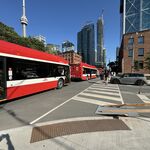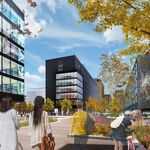Platform 27
Active Member
That extension would change the traveling habits of a lot of passengers. Those working in the financial district, west of University Ave. and those studying at U of T coming from Scarborough would stay on the train knowing what's waiting for them on the Yonge line. Do you waste time at Sheppard-Yonge watching overcrowded trains while waiting for a chance to squeeze in or keep you seat until Downsview and get a seat to get downtown?
I'm sorry, but this argument keeps coming up over and over and I always bite my tongue but I'm really getting sick of holding it. Forgive the oncoming rant.
A Sheppard West extension is less than useless at relieving downtown-bound pressure on Yonge. These hordes of people who might stay on Sheppard trains, skip Yonge, and use Spadina to go south into the core instead exist purely in people's imaginations.
Let's take an ideal person who'd benefit from a Sheppard West extension: someone who boards the subway system every morning at Don Mills en route to a job of some nature on Hospital Row at St. Patrick. Let's say right now they get on Sheppard subway at Don Mills at 8:00 am. Based on this TTC time chart (which builds in an average 4 minute transfer time delay at Sheppard-Yonge--debatable, but let's leave that alone for now), they can go west to Sheppard-Yonge, then south, go around the 'U' at Union, and reach St. Patrick at 8:40. People doing this commute in reality might find it faster to be getting out at Dundas and taking a streetcar or walking, but we'll ignore that option.
So let's do this again with a Sheppard West extension that runs over to current-day-Downsview. This hypothetical person still boards the Sheppard train at Don Mills at 8:00, and still gets as far as Yonge at 8:08, but now they stay on the train and keep going west. I don't know if there's a forecast run time buried somewhere in a report floating around out there somewhere, but based on the 4.3 km distance, and--for the sake of argument--2 intermediate stops, I'm going to say 7 minutes sounds about right. That puts them arriving at Downsview at 8:15. Let's then drop in the same 4 minute transfer lag as we did before, and then set off south on the Spadina line at 8:19. They roll into St. Patrick at... *drumroll*... 8:42.
So we've spent a cool couple of billion of dollars, and for our trouble the person whose geography seems perfectly aligned to avail of this new line now has a new, slower option. As you work around the 'U' through Osgoode, St. Andrew, Union, King etc. not only do you get into a more substantial share of the total volume of downtown destinations, but the size of the time penalty of taking the Downsview transfer option over the Yonge transfer option gets bigger and bigger. And let's not forget here, we're still really only potentially improving the commutes of a tiny slice of what is a comparatively puny number of riders on the Sheppard line to begin with.
But, you say, what about the crowding on the Yonge Line? Wouldn't this person be willing to trade 2 extra minutes, or 5 extra minutes, or 10 extra minutes, to avoid getting passed by a full train? First of all, this assumes a sort of geeky level of research and commute optimization that I think experience shows the vast majority of the public generally doesn't do. But secondly, let's be frank: if we're into a situation where southbound trains are routinely pulling out of North York Centre every morning with no room left for the entire rest of the Yonge line, then we have a much bigger problem in our hands that needs solving. I would suggest the magical $2+ billion that Sheppard West backers assume the government has under its mattress somewhere might be needed to tackle that problem, and I don't think the smartest way to spend it is by trying to divert a tiny fraction of Sheppard-to-Yonge transfers, which are a relatively minor contributor to Yonge's overall load to begin with.
It's not that a Sheppard West extension doesn't offer benefits to some members of the public. It does give the Sheppard East-catchment faster access to Yorkdale, York University, and whatever other substantive destinations might emerge on the Spadina extension someday in the distant future (VMC? Downsview Park redevelopment?). But in terms of trip generators (and even calling Yorkdale a trip generator is a bit of a stretch), that's it. Awkward truth, but thousands of people are not trying to get from Leslie station to the number 14 bus at Glencairn every day.
Last edited:







